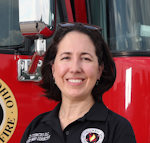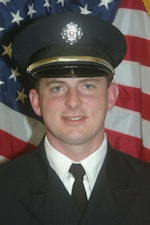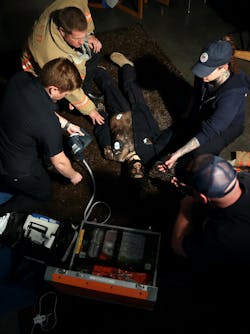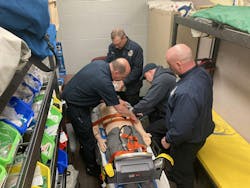Medical simulation in the prehospital environment is recognized as a pillar of schoolhouse training. It’s accepted widely in medical education that creating different simulation scenarios allows students to develop their problem-based thinking and practical skills. More importantly, it allows for mistakes in a safe, controlled environment. The main reason for this is patient safety.
Medical simulation
Medicine holds the primary tenet “Primum non nocere,” or “First, do no harm.” In the past, skills were developed solely in the clinical setting on live patients or inconsistently on manikins. Today’s medical simulation was inspired by aviation. The aviation community has used simulators since 1934, because simulators expose trainees to high-risk/low-frequency conditions, and scenarios can be reproduced and changed to tailor the needs of the trainee.
It also is important to note that simulation lends itself more to the adult learner, by satisfying some of the core tenets of adult learning theory.
Furthermore, trainees in medical education made the decision to enter the field. Therefore, they are self-directed and motivated to learn. At the same time, they often seek relevance and the practical need of what they are learning. Simulation satisfies this by demonstrating the “need to know” (Felipe Jones, et al, “Simulation in Medical Education: Brief history and methodology,” Principles and Practice of Clinical Research Journal), because scenarios mimic real life.
Despite the benefits of medical simulation, there are barriers to moving it from the schoolhouse to the firehouse. Often, this is because of limited equipment, finances and space. However, engaging a student’s mind through high-fidelity mediums doesn’t take an extremely large budget or even a high-fidelity manikin. Much can be accomplished through an inspirational instructor who has a good imagination and proper preparation.
Simulating the environment
The first step in enhancing scenarios and student learning is setting the stage.
There are many ways by which any manikin can be manipulated, such as moulage wounds and changes of clothing, but the biggest manipulation to a scenario is the environment.
In the prehospital environment, patients can be found anywhere. Obtaining furniture items and other household furnishings can create a more realistic scene and the obstacles that often are met. For example, one doesn’t need a whole bathroom to create the stress of caring for someone in a tight space. One simply can obtain an old toilet and set it in the corner of the room with another barrier or shelf. This helps to immerse learners in the scenario and to elicit more of a stress response because of the problem-solving that’s required compared with a manikin that simply is placed on the floor. For other scenarios, you can utilize props, such as bicycles or children’s toys, to supplement the environment. The use of a deployed airbag is a great addition for an MVA scenario. It can be used in various locations both inside and outdoors.
What if you can’t obtain household furnishings and/or barriers? The arrangement for equipment storage or refurbishment of a supply area can serve a dual-purpose role during scenarios. The mere placement of shelving and seating can create the ambiance of being inside of a transport ambulance. This also can be used to extend an in-house scenario from initial treatment and stabilization to loading the patient and then bringing the student and patient into the simulated ambulance environment for continuance of care to the receiving facility.
The next addition or scenario manipulation is the use of audio recordings. These often are played over a working TV, computer screen or set of computer speakers. This stimulates a sensory response and provides an adjustable level of distraction. Examples of sounds that can be used include animal noises, fire/EMS radio traffic, TV shows and cartoons.
Manipulating the lighting of the environment for daytime versus nighttime or inside versus outside calls is another technique. If a scenario involves a victim in the roadway, you can turn the lights out in the room and provide a quartz light or other means to light an area, which would mimic the scene lighting from an apparatus.
Finally, add patient audio, and record the scenario. Anytime that you can utilize technology to remove a facilitator from a scenario forces learners to interact more directly with manikins and makes scenarios more real. If you have the budget, this can be obtained through a high-fidelity manikin, but for most agencies this can be difficult to obtain. Instead, by using a network of cameras, such as a wireless home security or surveillance system, you can watch the crew operate from a separate room. Even indoor Wi-Fi cameras have microphones that allow you to listen to learners’ questions and discussions while you provide feedback in real time.
If you obtain cameras, get ones that record. Debriefing the scenario and providing good feedback are the most important segments of a simulation session. In this moment, the learner has an opportunity for reflection by discussing his/her performance. Being able to not only think about the scenario but to see one’s performance can solidify the learning goals.
Providing challenges
In the world of fire and EMS training, simulation has been solidified as an important component to schoolhouse training, but because of certain barriers, it often isn’t performed in the firehouse. With a few simple, creative modifications, an instructor can make simulation a continuing education fixture in the firehouse while challenging the learner’s adaptability and intellectualization.

Janine Curcio
Janine E. Curcio, D.O., is a board-certified emergency medicine and emergency medical services physician. Curcio attended the U.S. Naval Academy and served in the U.S. Navy as a P-3 naval flight officer. Curcio attended medical school at Lake Erie College of Osteopathic Medicine. She completed her residency and fellowship at the OhioHealth Doctors Hospital. Curcio works clinically at OhioHealth Grady Memorial Hospital in addition to her time with Columbus, OH, Division of Fire.

Josh Byran
Josh Bryan began his fire and EMS service career in 1996. Today, he is a full-time instructor for the Columbus, OH, Division of Fire. Bryan also is a captain for the Newton Township, OH, Fire Department who also serves as the program director, overseeing the department’s state fire charter and accredited EMS academy for the past 10 years. He holds a Bachelor of Science in public safety management & leadership from Franklin University and an associate of applied science degree in fire science from Eastern Gateway Community College.







